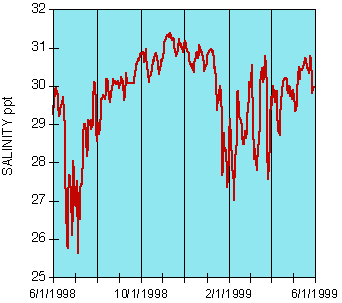3. What is the salinity of Narragansett Bay?
The average surface salinity of Narragansett Bay is between 24 and 32 ppt . The bottom water is always saltier (higher salinity) than the surface water. The salinity varies in different parts of the Bay. Near rivers, the salinity will be lower and near the ocean the salinity will be higher. In the Providence River near the hurricane barrier, the salinity can be as low as 13 ppt after a large rain storm.
Factors affecting the salinity of Narragansett Bay:
 |
| Salinity (ppt) at the URI Bay Campus dock in 1998 and 1999. The highest salinity tends to occur in the winter. Lower salinities generally occur in the spring when there are large rain storms. |
What is the salinity in the open ocean?
| 


